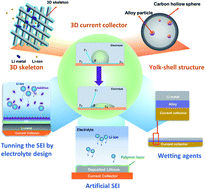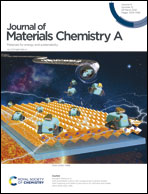Interfacial chemistry in anode-free batteries: challenges and strategies
Abstract
Since the first commercialization of the “rocking chair” battery in the 1990s, the energy density of lithium-ion batteries has increased continuously. To reach higher energy density, the anode-free configuration has been suggested and intensively studied in recent years. In an anode-free battery, the Li deposits on the bare current collector (CC) in the first discharge without any host materials. Therefore, the anode-free configuration could be considered as a special kind of Li-metal battery. Although the anode-free design enhances the battery's energy density by decreasing network weight, the low coulombic efficiency (CE) and Li dendrite restrict the practical application. The interfacial issues, such as nonuniform deposition of lithium and parasitic reactions at the CC|Li-metal|electrolyte interfaces, are responsible for the low CE value and dendrite growth. To address these problems, tuning the CC|Li-metal|electrolyte interfacial chemistry has been considered as a promising approach. Diverse strategies have been used to modify the CC|Li-metal|electrolyte interfaces in the last few years. This review provides readers an overview of interfacial chemistry in anode-free batteries, including the interfacial problems and interfacial engineering strategies. Moreover, the interfacial modification strategies for the solid-state anode-free battery are also discussed. New approaches are expected to be developed to further improve the cycling stability of the anode-free batteries.

- This article is part of the themed collection: Journal of Materials Chemistry A Recent Review Articles


 Please wait while we load your content...
Please wait while we load your content...